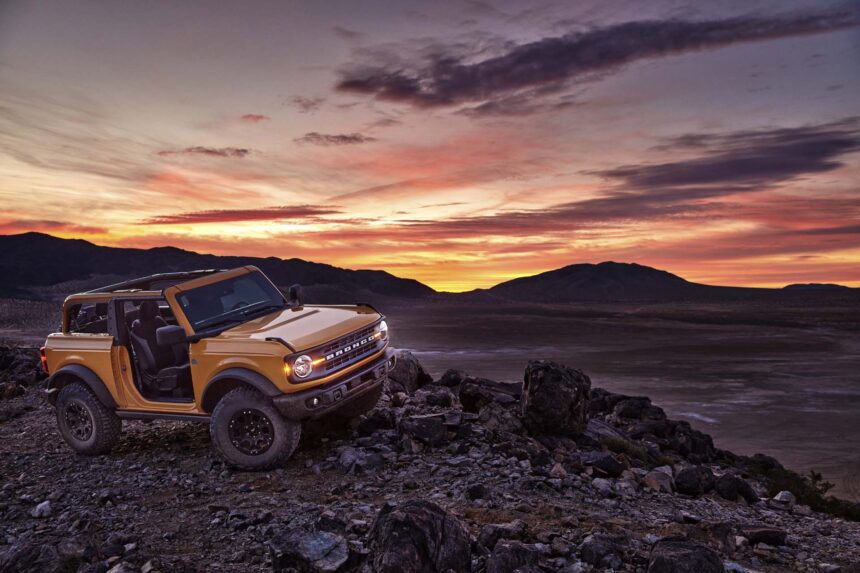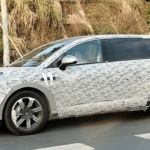Wrangler: A Detailed Comparison of Two Off-Roading Icons
When it comes to off-roading capability, two names stand out above the rest: the Jeep Wrangler and the Ford Bronco. These iconic SUVs have captured the hearts of adventurers and outdoor enthusiasts for decades, with their rugged design and impressive performance both on and off the road. In this article, we will take a deep dive into the key differences between the Jeep Wrangler and the Ford Bronco, helping you determine which one is the best choice for your off-roading adventures.
The Jeep Wrangler has long been considered the benchmark for off-roading capability in America. With its roots tracing back to its development for military use during World War II, the Wrangler has become synonymous with adventure and exploration. Its removable doors and tops, along with its ducky personality, have made it a favorite among a wide range of enthusiasts, from extreme off-roaders to everyday drivers.
On the other hand, the Ford Bronco made a triumphant return in 2021, setting its sights on challenging the Wrangler’s dominance in the off-road SUV market. While the Bronco also offers removable doors and a top, it comes with a more modern suspension system compared to the Wrangler, along with a host of safety features and technology. The Bronco’s retro styling pays homage to its heritage while incorporating modern design elements for a fresh and capable off-roading experience.
Both the Wrangler and the Bronco face competition from other off-road vehicles, such as the Land Rover Defender and off-road versions of midsize pickups. However, they remain the top choices for those looking for a highly capable off-roader straight out of the box. Let’s now compare the prices and features of the Ford Bronco and Jeep Wrangler to help you make an informed decision.
Bronco vs. Wrangler: Prices and Features
- Base Wrangler costs about $34,000
- Base Bronco costs about $40,000
- Best picks: Bronco Black Diamond and Badlands, Wrangler 4xe Sport S, Willys, and Rubicon
How much is a Ford Bronco?
The Ford Bronco comes in nine different models, each catering to a specific type of off-roading experience. The base model, the Big Bend, starts at around $42,000 and comes equipped with a range of features, including a 12.0-inch infotainment touchscreen, wireless Apple CarPlay and Android Auto, and removable doors and top. For those looking for a more off-road-focused experience, the Black Diamond model, priced at around $47,000, adds rock rails, powder-coated steel bumpers, and full underbody skid plates.
At the top of the Bronco lineup is the Raptor model, which comes with a price tag of over $92,000. This model includes advanced off-road features such as Fox internal bypass-valve dampers, 37-inch tires, and a surround-view camera system. Whether you’re a casual off-roader or a hardcore enthusiast, the Bronco offers a range of models to suit your needs.
How much is a Jeep Wrangler?
The Jeep Wrangler is available in multiple models, including the Sport, Willys, Sahara, High Altitude, Rubicon, and Rubicon 392. The base Wrangler Sport starts at around $34,000 and comes with essential off-road features such as removable doors, a fold-down windshield, and 17-inch steel wheels. For those looking for a more premium off-roading experience, the Rubicon model, priced at around $49,000, offers heavy-duty axles, front and rear locking differentials, and a disconnecting front sway bar.
The Wrangler lineup also includes the 4xe Sport S model, a plug-in hybrid option priced at around $52,000, which offers better fuel economy and additional features such as power doors and locks. With a diverse range of models to choose from, the Wrangler caters to a wide range of off-roading preferences and budgets.
Advantage: Ford Bronco for Better Equipment
In conclusion, both the Jeep Wrangler and Ford Bronco offer impressive off-roading capabilities and a range of models to choose from. The Wrangler has a long-standing reputation as an off-road icon, while the Bronco brings modern technology and safety features to the table. Whether you prefer the classic charm of the Wrangler or the modern amenities of the Bronco, both SUVs are sure to provide you with an unforgettable off-roading experience.
Wrangler Fuel Economy
When it comes to fuel economy, the Jeep Wrangler and Ford Bronco both offer a range of engine options to suit different needs. The Wrangler’s base V-6 engine has a fuel economy of 18/24/20 mpg, while the turbo-4 engine offers slightly better fuel efficiency at 20/23/21 mpg. The Wrangler 4xe plug-in hybrid provides even better fuel economy with an EPA rating of 20 mpg combined when running on gas only.
On the other hand, the Ford Bronco’s base turbo-4 engine has a fuel economy of 20/21/20 mpg, while the V-6 engine offers a fuel economy of 19/21/20 mpg. The Bronco Raptor, with its twin-turbo V-6 engine, has a fuel economy of 15/16/15 mpg.
Overall, the Wrangler’s plug-in hybrid option provides the best fuel economy of the two vehicles, making it a more environmentally friendly choice for those looking to save on fuel costs.
Advantage: Jeep Wrangler for better fuel economy with the plug-in hybrid option.
Bronco vs. Wrangler Towing Capacity
When it comes to towing capacity, both the Jeep Wrangler and Ford Bronco offer impressive capabilities. The Wrangler can tow up to 5,000 pounds with the Rubicon 392 model, while the other versions have towing capacities of either 2,000 or 3,500 pounds.
On the other hand, the Ford Bronco can tow up to 4,500 pounds in Raptor form, while most of the lineup is rated at 3,500 pounds. Both vehicles offer strong towing capabilities, making them suitable for hauling trailers, boats, and other heavy loads.
Overall, both the Jeep Wrangler and Ford Bronco offer excellent towing capacities, making them versatile vehicles for those who need to tow heavy loads.
Advantage: Jeep Wrangler for higher towing capacity with the Rubicon 392 model.
In conclusion, both the Jeep Wrangler and Ford Bronco offer impressive performance, fuel economy, and towing capabilities. The Wrangler has a range of engine options, including a plug-in hybrid for better fuel economy, while the Bronco offers a smoother ride and better steering. Both vehicles excel off-road, with the Wrangler’s Rubicon model leading the pack in terms of off-road features, while the Bronco offers more advanced off-road technology. Ultimately, the choice between the two vehicles will depend on individual preferences and priorities, but both are excellent options for those looking for a capable and versatile off-road vehicle.
The Jeep Wrangler and Ford Bronco are two iconic off-road vehicles known for their ruggedness and versatility. When it comes to size, dimensions, and cargo space, there are some key differences between the two.
The Wrangler is the smaller of the two vehicles, but its four-door model offers more rear legroom compared to the Bronco. The Wrangler seats four in the two-door version and five in the four-door version. It has a wheelbase of 96.8 inches for the two-door and 118.4 inches for the four-door. The two-door Wrangler has a length of 166.8 inches, while the four-door version measures 188.4 inches. The cargo capacity behind the second row is 31.7 cubic feet for both body styles, with 72.4 cubic feet behind the first row.
On the other hand, the Bronco is slightly larger than the Wrangler. It offers 43.1 inches of front legroom and seats four in the two-door model and five in the four-door model. The two-door Bronco has a wheelbase of 100.2 inches and a length of 173.7 inches, while the four-door version has a wheelbase of 116.1 inches and a length of 189.4 inches. The cargo capacity behind the second row is 22.4 cubic feet for the two-door and 38.3 cubic feet for the four-door. Behind the first row, the two-door Bronco offers 52.3 cubic feet of cargo space, while the four-door provides 83.0 cubic feet.
In terms of overall space, the Bronco has the advantage with more cargo space and slightly more rear legroom in the four-door model. However, the Wrangler offers a more compact size, which may be preferred by some off-road enthusiasts.
When it comes to infotainment, technology, and safety features, both vehicles have good systems, but the Bronco edges out the Wrangler with standard automatic emergency braking and better crash-test scores. The Wrangler lacks standard automatic emergency braking and has mixed safety ratings from the NHTSA and IIHS. In contrast, the Bronco comes standard with safety features like automatic emergency braking and earns good crash-test scores from the IIHS.
Overall, the Ford Bronco emerges as the winner in this comparison, with higher ratings for interior comfort, features, performance, and safety. While the Jeep Wrangler is still a great off-roader and offers a lower starting price, the Bronco’s better safety equipment and overall performance make it the preferred choice for many buyers. Is Technology Making Us Lazy?
In today’s modern world, technology plays a significant role in our daily lives. From smartphones to smart home devices, technology has made our lives more convenient and efficient. However, with the rise of technology, there has been a growing concern that it is making us lazy.
One of the most common arguments is that technology has made us reliant on automation and convenience, leading to a decrease in physical activity. For example, instead of walking to the grocery store, we can simply order groceries online and have them delivered to our doorstep. Similarly, instead of picking up the phone to make a call, we can send a quick text message or email. These conveniences have undoubtedly made our lives easier, but they have also contributed to a more sedentary lifestyle.
Additionally, technology has made it easier for us to procrastinate and avoid tasks that require effort and discipline. With the rise of streaming services like Netflix and Hulu, we can binge-watch our favorite shows for hours on end without having to leave the comfort of our couch. Social media platforms like Facebook and Instagram also provide endless entertainment and distractions, making it easy to waste hours scrolling through our feeds.
Furthermore, the rise of artificial intelligence and machine learning has led to the automation of many jobs and tasks that were previously done by humans. While this has increased efficiency and productivity in many industries, it has also led to concerns about job loss and a lack of motivation to learn new skills.
However, it is important to note that technology is not inherently good or bad – it is how we choose to use it that determines its impact on our lives. While technology has made certain tasks easier and more convenient, it is up to us to ensure that we are still engaging in physical activity, challenging ourselves mentally, and practicing self-discipline.
In conclusion, technology has undoubtedly made our lives more convenient, but it has also led to concerns about laziness and a lack of motivation. It is important for us to strike a balance between using technology to enhance our lives and ensuring that we are still actively engaging in physical and mental activities. Ultimately, it is up to us to take control of our technology usage and make conscious choices that promote a healthy and balanced lifestyle.







